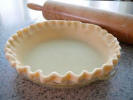  This long known cultivar was registered
in 1999 by
Peter Ruh of Ohio on behalf of the originator,
Thomas Donahue of Massachusetts. It is a large size plant (28
inches high by 60 inches wide) with dark green leaves
that have
prominent ripples (piecrusting) along the edges. Near white, fertile flowers
bloom from late June into July on scapes about 27
inches tall. This long known cultivar was registered
in 1999 by
Peter Ruh of Ohio on behalf of the originator,
Thomas Donahue of Massachusetts. It is a large size plant (28
inches high by 60 inches wide) with dark green leaves
that have
prominent ripples (piecrusting) along the edges. Near white, fertile flowers
bloom from late June into July on scapes about 27
inches tall.
According to
The Hosta Handbook by Mark Zilis (2000), "...'Donahue Piecrust' has the reputation of being the
best parent for "piecrust" hostas. A very high percentage of its
seedlings inherit the genetic trait for rippled margins."
The Hostapedia by
Mark Zilis (2009)
states, "In the garden, it makes a magnificent
specimen, but can also be used as a background plant or large
ground cover...registered as a hybrid of
H. montana
(Stevenson 2000), but more likely a seedling of 'Fortunei
Gigantea' or 'Green
Piecrust'..."
The New Encyclopedia of Hostas by
Diana
Grenfell (2009) states: "Slow to
increase. The spectacular piecrust edge takes
several years to develop fully. This parent of
earlier introductions with piecrust edges has been
superseded as a garden plant."


An article by Kevin Walek in
The
Hosta Journal (2008 Vol. 39 No. 2) states that, "H.
'Candy Dish' and its pod parent, 'Urajiro Hachijo', probably a form of
H. longipes, both show potential for breeding outstanding piecrusted
cultivars...Think about how many people coveted 'Donahue Piecrust' for its wavy
edge and coloration. Now think about the same look on a much smaller leaf, with
a much smaller and tighter clump. You can imagine the possibilities."
Mikiko Lockwood in an article on The Hosta Library titled,
A Little About Japanese Hosta Terms defines the term urajiro as white-backed or white underside.




 |



